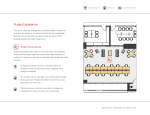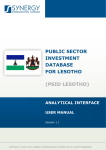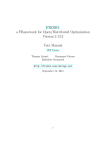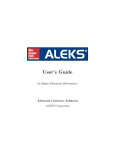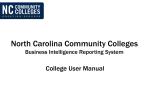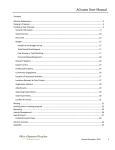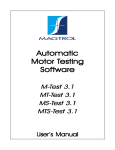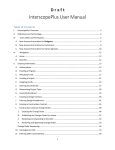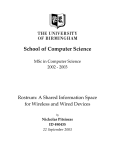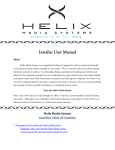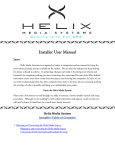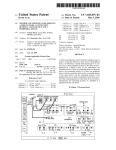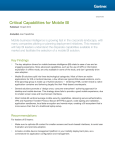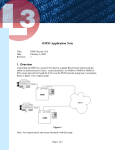Download CCC&TI Planning Handbook - Caldwell Community College and
Transcript
2015 CCC&TI Planning 1 CCC&TI Planning Institutional and Program Planning Handbook Office of Institutional Effectiveness and Research Fourth Edition, January 2015 2 CCC&TI Planning Table of Contents Introduction ...........................................................................................................................3 Goals of planning ...................................................................................................................3 Background ............................................................................................................................3 SACS .......................................................................................................................................3 NCCCS Guidelines..................................................................................................................4 Planning and Assessment: What is the difference? .....................................................5 Assessment ............................................................................................................................. 5 Planning ................................................................................................................................. 5 Strategic Planning.................................................................................................................6 CCC&TI Strategic Planning ....................................................................................................6 Institutional Achievement Plan .............................................................................................6 The Plan of Action .................................................................................................................7 Unit Priority ........................................................................................................................... 7 Strategic Plan Reference ........................................................................................................ 7 Strategy for Improvement...................................................................................................... 7 Documentation of Need ......................................................................................................... 7 Request for Funding............................................................................................................... 7 Closing the Loop..................................................................................................................... 7 The CCC&TI Planning Process .......................................................................................... 8 Annual Planning.....................................................................................................................8 Annual CCC&TI Planning/Budget Retreat ...........................................................................8 Managing the Planning Process at CCC&TI....................................................................9 Appendix A: Using Compliance Assist: Planning Module ........................................10 Appendix B: Institutional Effectiveness Calendars .................................................. 26 Appendix C: 50 and Beyond (2015-2020 Strategic Plan) ........................................ 28 Office of Institutional Effectiveness and Research | 2015 CCC&TI Planning 3 Introduction The Caldwell Community College and Technical Institute (CCC&TI) planning process is a ground-up approach to planning, focusing on the needs of individuals and programs within the institution while still supporting the institutional mission and five year strategic plan. Goals of planning 1) Utilize assessment results and other supporting data to a. identify needs for program, departmental, divisional, and institutional improvement; b. support funding requests at the program, departmental, divisional, and institutional level. 2) Develop a process for encouraging and maintaining a culture of data‐based decision making 3) Establish an ongoing system to demonstrate institutional effectiveness of the type required by programmatic and regional accrediting bodies. Background SACS The Southern Association of Colleges and Schools (SACS) is the regional accrediting agency for CCC&TI. SACS has been using the accreditation process to introduce and foster a culture of institutional effectiveness within its member institutions. Below are portions of the SACS publication Principles of Accreditation: Foundations for Quality Enhancement, Fifth Edition that speak most directly about SACS expectations regarding the institutional planning process. Section 2: Core Requirements CR 2.5 The institution engages in ongoing, integrated, and institution-wide research-based planning and evaluation processes that (1) incorporate a systematic review of institutional mission, goals, and outcomes; (2) result in continuing improvement in institutional quality; and (3) demonstrate the institution is effectively accomplishing its mission. CR 2.11.1 The institution has a sound financial base and demonstrated financial stability to support the mission of the institution and the scope of its programs and services. The member institution provides the following financial statements:… (3) an annual budget that is preceded by sound planning… Office of Institutional Effectiveness and Research | 2015 4 CCC&TI Planning Section 3: Comprehensive Standards CS 3.3.1 The institution identifies expected outcomes, assesses the extent to which it achieves these outcomes, and provides evidence of improvement based on analysis of the results in each of the following areas: 3.3.1.1 educational programs, to include student learning outcomes 3.3.1.2 administrative support services 3.3.1.3 academic and student support services 3.3.1.4 community/public service within its mission, if appropriate Additional standards Regardless of the requirement, standard, policy, or guideline, SACS expects assertions to be backed up with supporting evidence. Much of this evidence is provided through effective planning and assessment processes. North Carolina Community College System (NCCCS) Guidelines In addition to SACS accreditation requirements, NCCCS mandates that all community college in North Carolina have an annual planning process resulting in an institutional effectiveness plan which supports the mission of the college. In its 1989 session, the North Carolina General Assembly adopted a provision (S.L.1989; C. 752; S.80) which mandated that: Each college shall develop an institutional effectiveness plan, tailored to the specific mission of the college. This plan shall be consistent with the Southern Association of Colleges and Schools criteria and provide for collection of data as required by the “Critical Success Factors” list. In order to allow community colleges the flexibility they need to develop an effective plan while meeting the mandates of the General Assembly and the State Board of Community Colleges, the following guidelines should be followed: 1. All colleges must develop and implement an annual planning process that results in an institutional effectiveness plan. Colleges have the flexibility to develop biennial plans as long as a process of annual review and revision is in place. It is expected that each college will follow the principles of good planning. Office of Institutional Effectiveness and Research | 2015 CCC&TI Planning 5 Planning and Assessment: What is the difference? It is easy to become caught up in the terminology involved in the institutional effectiveness process. Instead, it is helpful to focus on the purpose behind the planning and assessment processes. Assessment Assessment is outcome oriented. Assessment should answer questions like “How well are our students learning?” and “How well are our administrative and academic support services functioning?” The process of assessment should be continuous – 1. Identify the desired outcomes (goals, objectives) for your students or for other members of the institution 2. Determine clear and accurate ways to measure achievement of these outcomes 3. Determine your expectations for successful achievement of these outcomes 4. Gather data to show how successful or unsuccessful you were in achieving these outcomes Planning Planning is process oriented. Planning should focus on actions to improve student success, services offered, efficiency, etc. and should always result from formal or informal assessment. At CCC&TI, we formally (through documentation) plan in two ways: 1. As they become available, assessment results are reviewed and plans for program improvement are made. We call this the “use of results for improvement” and these improvement plans are documented in the final column of our Assessment Report. 2. Each spring, programs complete a Plan of Action (POA) indicating the actions they will take during the upcoming year to make improvements to their program or service. We call these “strategies for improvement” and they are reviewed up the organizational line to determine departmental, divisional, and institutional planning priorities. Ideally, the “use of results for improvement” and the “strategies for improvement” should be the same since planning should always result from assessment. We separate the documentation of these plans for improvement, however, because there are instances when formal assessment and planning do not overlap. There may be external changes or broad program changes that will affect student success but do not need to be included on a Plan of Action. More likely, there may be internal funding requests (office equipment, for example) that need to be included on a Plan of Action but are not necessarily supported by assessment results. In general, however, assessment results should support planning. Office of Institutional Effectiveness and Research | 2015 6 CCC&TI Planning Strategic Planning CCC&TI Strategic Planning Strategic planning at Caldwell Community College and Technical Institute is an in-depth, allencompassing process culminating in a five year long-range plan and strategic plan. The goals, directives, and initiatives outlined by the plan guide annual planning through five years in an effort to meet the institutional missions and respond to the needs of the community. The first strategic plan, Beyond 2000: A Strategic Plan, was released in 1999 for 2000-2005 and marked the beginning of a strong, inclusive process. CCC&TI planning is currently steered by 50 and Beyond: Foundations for the Next Half Century, 2015-2020 Strategic Plan. The strategic planning process is completed over two years and is directed by the office of institutional effectiveness and research and supported by the college planning council. Beginning with a review of the current institutional mission, vision, core values and strategic plan, an initial environmental scan and data collection is conducted and faculty, staff, and students are surveyed to determine future critical issues in education and the community. Analysis of this data provides the base for CCC&TI Future Search which invites Board of Trustee members, faculty, staff, students and community partners to contribute to the building of a new strategic plan. In 2012-2013, CCC&TI began the strategic planning process for the fourth time to develop the 2012-2017 long-range plan and 2015-2020 strategic plan. During spring 2013, after a thorough collection and analysis of internal and external data, Future Search IV focus groups with faculty, staff, and students were conducted internally. In November 2013, after review of internal discussion, the Future Search IV Conference was held at the J. E. Broyhill Civic Center, gathering community members from Caldwell and Watauga counties to discuss critical issues impacting the future of CCC&TI and the needs of the surrounding community. The office of institutional effectiveness and research and college planning council compiled all results and developed a new strategic plan. The final plan was approved by the Board of Trustees December 2014 and in place February 2015 to direct planning for 2015-2020. Institutional Achievement Plan Using the completed strategic plan, faculty and staff from across the institution determine improvement objectives relating to appropriate strategic initiatives and specific to their division. These objectives are refined by the office of institutional effectiveness and research and approved by college planning council to create the institutional achievement plan. These objectives will be the main focus of institutional planning and ensure that all plans of action are guided by the current strategic plan. The institutional achievement plan is reviewed annually in conjunction with divisional closing the loop plan of action reports and updated to document how CCC&TI is achieving its strategic goals. Office of Institutional Effectiveness and Research | 2015 CCC&TI Planning 7 The Plan of Action As mentioned previously, planning focuses on the actions a program, department, division, or institution will take in order to meet goals or outcomes or improve current processes or services. At CCC&TI, we document and track these actions with the plan of action. A plan of action has six main components: Priority The “priority” indicates the level of importance this action or strategy holds to the program, department, division, or institution. If the strategies were to be ranked in order of importance for completion, where would this strategy fall? Strategy for Improvement The “strategy for improvement” is the specific action an individual, program, department, or division plans to take for improvement in the coming year. Many of these strategies will reflect changes needed based on assessment results and may or may not require funding. Documentation of Need The “documentation of need” should include assessment results, additional data, and any other information that explains why the strategy is necessary for improvement. If the strategy requires funding, this is where an argument can be made for the importance of the personnel, equipment, etc. Request for Funding This is a simple indication of whether the strategy requires funding and, if so, requires the completion of the “Budget Worksheet” section. Closing the Loop At the end of the planning year, program directors should close the loop by completing the “status of strategy” and “results of the strategy.” Closing the loop brings planning full circle by reviewing the intended strategy, the actual results (was the strategy completed as planned?), and what actions will be taken in the future if the strategy was not implemented as planned. Related Strategic Plan Objective The final component, the “related strategic plan objective,” links the strategy to the strategic plan. Since the strategic plan represents the planning priorities for the institution (the goals and objectives the institution has decided to be most important over a five year period), planning from the program level up should reflect a commitment to these priorities. Office of Institutional Effectiveness and Research | 2015 8 CCC&TI Planning The CCC&TI Planning Process Annual Planning The annual planning process at CCC&TI begins at the program level with faculty, staff, and directors identifying program-specific priorities to facilitate improvement. Early in the spring semester, individual faculty and staff indicate position objectives and accompanying needs for the coming academic year and meet with the program coordinator and/or director to discuss program strategies for improvement. After review of the institutional achievement plan, the current plan of action, and any available assessment results, faculty, staff, and the program director develop a plan of action to be implemented beginning that fall. The plan of action is a compilation of strategies for improvement based on current program assessment, prioritized by need, that will direct planning and implementation for the next year. Each strategy for improvement links directly to an improvement objective on the institutional achievement plan and strategic plan and provides documentation of need. Program directors are encouraged to include all planned strategies, including those that do not require funding. Program plans of action are then reviewed at the department level by program directors and department chairs and prioritized department strategies for improvement are identified on a department plan of action. Department plans of action are reviewed by department chairs and the divisional vice president to develop a final divisional plan of action which will be presented at the annual CCC&TI planning/budget retreat held each May. Annual CCC&TI Planning/Budget Retreat The annual planning/budget retreat is a full day meeting, facilitated by the office of institutional effectiveness and research, and held each May during which executive council members determine by vote the institutional priorities for the next planning year. In addition to the presentation of institutional priorities and divisional plan of action strategies for approval, executive council members review the current planning cycle, institutional accomplishments, budget expectations, and concerns for the upcoming year. After the conclusion of the retreat, the executive vice president and vice president of finance and administration produce a summary of the retreat, including a list of institutional priorities for the next planning cycle. The office of institutional effectiveness and research develops the institutional plan of action identifying these same institutional priorities and both documents are combined and disseminated to all faculty and staff. The institutional effectiveness plan is updated in June and posted on the CCC&TI website to begin the new planning year. Office of Institutional Effectiveness and Research | 2015 CCC&TI Planning 9 Managing the Planning Process at CCC&TI Office of institutional effectiveness and research All planning efforts begin at the program level with needs and strategies for improvement identified by faculty and staff. Strategies should reflect the needs and plans of each program area, regardless of funding, and only those items requiring institutional funding and/or approval continue through the institutional process. The office of institutional effectiveness and research (OIER) provides direction and support in the planning process at CCC&TI and facilitates process improvement. OIER is also responsible for facilitating the institutional and strategic planning processes and producing the institutional achievement plan and institutional effectiveness plan each year. These documents are available on the college website and under the Institutional Effectiveness and Research section in Portal. College planning council also monitors and facilitates institutional effectiveness at CCC&TI. Membership includes the president, executive vice president, divisional vice presidents, faculty senate president, SGA student representative, and director of institutional effectiveness and research (ex-officio). Any questions related to planning at CCC&TI or institutional effectiveness in general should be directed to the office of institutional effectiveness and research at 828-726-2375 or [email protected]. Please remember – our office exists to facilitate and support the process of institutional effectiveness and this includes supporting faculty, staff, and administration in understanding and utilizing assessment, planning, program review, and other available data effectively for decision-making and program and institutional improvement. Do not hesitate to contact our office with any questions or concerns! Office of Institutional Effectiveness and Research | 2015 10 CCC&TI Planning Appendix A: Using Compliance Assist: Planning Module Introduction to Compliance Assist Beginning in the fall of 2011, Caldwell Community College and Technical Institute began implementing the use of Compliance Assist (CA) online software to manage its institutional effectiveness process. Since then, the college has implemented the use of CA: Accreditation to complete its SACS Fifth-Year Interim Report, CA: Program Review to complete the program review process, and CA: Planning to complete assessment and planning processes. *Terminology note: Compliance Assist only has ONE module for planning and assessment. It is called “Planning”. Don’t be confused by this! All planning and assessment is located in this module. CA only uses “Planning” because, ideally, the assessment and planning processes should feed into each other and should be one continuous cycle. Getting Started in Compliance Assist User Login and Permissions Every coordinator, director, department chair, and vice president has a username and permissions in Compliance Assist. If any other faculty or staff member also needs access to any part of CA, please contact OIER to set up a user account. User Name = your email address without the “@cccti.edu” (ex. kbenoit) Password = password1 (all lowercase) You will be prompted to change your password upon your first login. You can choose any password you want. If you forget your password or need login assistance, contact OIER. Your password will be reset to “password1” again. OIER does not have access to any password you create. Office of Institutional Effectiveness and Research | 2015 CCC&TI Planning 11 To log out or reset your password, you can access your account by clicking on your name at the top of any page. Permissions in CA: Planning are granular and are managed by assigning roles to each user. Any user can have as many roles in as many areas as necessary. Because permissions can be specific and can vary by area, OIER will handle assigning roles in CA. If you need your permissions or the permissions for someone in your area changed, please contact OIER. By default, users will have permission to create and edit items at their level and below – for example, if you are a program director, you will only have access to your program and any documents pertaining to it. If you are a department chair, you will have access to all programs within your department. Common Fields and Buttons The following things are found across the CA: Planning module and are important to know. You will see these in most of the tabs and forms you are working in, so they will be explained here and not repeatedly throughout this handbook. Office of Institutional Effectiveness and Research | 2015 12 CCC&TI Planning SAVE FREQUENTLY!! In CA, there are two save options – “Save” and “Save & Close.” Clicking the Save button will save any new information you have entered and keep you in editing mode so you can continue working. Clicking Save & Close will save any changes and exit the form. Every time you save a change, an archive is created. If you want to go back to previous versions of your form or if you accidently make a change or delete text and need to restore a previous version, you can go to the “Activity” tab on any form and “View Archived Version.” You cannot actually restore previous versions, but you can copy and paste any text from archives into your current form. Only the user who made the change can access the archived version. If another user makes a change and you need to correct it, however, you can also see all user activity for any form under this tab. All items in CA must have at least the first three fields (program, number, title) populated and saved, before ALL options for the form are available to use. You will notice, unlike the image above, new items will not have any tabs at the top. Once the item is saved, it will refresh with these tabs. All items, regardless of the area you are under, have the same tab options. 1. View – where you can see the final version of an item outside of edit mode. 2. Edit – opens edit mode on already existing items. 3. Related – every item type in CA: Planning can be linked to other item types. For example, our Strategies for Improvement are linked to the Strategic Plan (objectives). Each item is preset with the other items it supports or is supported by: a. Items This … Supports – any item above this one (i.e. improvement objectives are supported by strategies for improvement) b. Items Supporting This… - any item beneath this one (i.e. strategies for improvement are supporting improvement objectives) Office of Institutional Effectiveness and Research | 2015 CCC&TI Planning 13 The items that appear in each tab can be filtered by clicking on the blue “Edit Filter” button. Items can be filtered by academic year and each item type within that tab (outcomes, strategies, etc.) can be selected or unselected. If you need help with Compliance Assist at any time, you can click the “Help” button in the upper right corner of any page. This will open the CA user manual and take you directly to the section applicable to the page you are on. If you still need assistance, you can always contact OIER for help. Office of Institutional Effectiveness and Research | 2015 14 CCC&TI Planning Home Announcements After logging in, all users should be directed to the CA: Planning Home which shows all current announcements. Any resources for completing planning and assessment will be located here, as well as any announcements regarding future training or changes in CA. My Dashboard My Dashboard is where most users will be working. This section holds all planning and assessment items and all permissions are based on a user’s role (or roles). This means that you will only see the areas and items that you have access to view, create, or edit. Also, by default, you will be taken directly to your area (program, department, or division), making it easy to find your information. My Roles Office of Institutional Effectiveness and Research | 2015 CCC&TI Planning 15 Upon entering My Dashboard, you will always see the “My Roles” tab first. Every role you have been assigned will be listed here. Most users will only have one role based on their position at the institution (coordinator, director, etc.). Users responsible for multiple areas or information in a variety of areas may have multiple roles. Faculty or staff can also be added as users and assigned certain roles and permissions to assist with the completion of planning or assessment. Administrative assistants or faculty may need to have roles in certain areas with very specific permissions and responsibilities. Please contact OIER to discuss any need to have additional users in your area. Each role will expand to show any items within CA: Planning where responsibility has been assigned. Most users will only see a few types of items listed here – Program Assessment Measures (P. AM), General Education Assessment Measures (GE. AM), or Strategies for Improvement (the compass icon). On the My Roles page, the following information will be listed: 1. 2. 3. 4. 5. 6. Type – the type of item (P. AM, GE. AM, etc.) Number – the program priority for strategies for improvement Name – description of strategy and the link to open the item Start – the beginning of the planning year (follows the academic year) End – the end of the planning year (follows the academic year) Progress – the status of that assessment measure **Responsibility in this context means responsibility for completion of that particular item within CA. Even though there are usually multiple people responsible for the collection and analysis of data in assessment, roles should only be assigned in CA based on responsibility for completing the forms within CA: Planning. Office of Institutional Effectiveness and Research | 2015 16 CCC&TI Planning Clicking on the title of any item in the list will open it. As long as a user has been assigned responsibility to an item, all editing can be done from the My Roles tab. CCCTI Strategic Plan The CCCTI Strategic Plan tab holds the institutional mission, vision, and core values, the current strategic plan (and any future strategic plans), and all program missions. Office of Institutional Effectiveness and Research | 2015 CCC&TI Planning 17 Directors will have access to create and edit program missions under this tab. All other items are informational. All users will be able to run a Strategic Plan report that will pull a complete strategic plan for reference (see section on Reports). Program Planning Under the Program Planning tab, users will create and edit Strategies for Improvement for the program, department, or division. Like the other areas in My Dashboard, users will be taken directly to their program area and see any items for the current academic year. Office of Institutional Effectiveness and Research | 2015 18 CCC&TI Planning To create a new Strategy for Improvement, hover the mouse over the “New Item” button and select the Strategy for Improvement form (with the compass icon). The Strategy for Improvement form will have the following fields available: 1. Program - automatically completed based on the program you are currently under. 2. Strategy for Improvement Title – a brief title to describe your strategy. This is what will show in your list of strategies under the Program Planning tab and distinguishes one strategy from another. It can be whatever you want but needs to clearly identify the strategy so you can tell them apart. 3. Program Priority – the priority number the program wants to assign to this strategy, based on importance. #1 would be the most important. 4. Department, Division, and Institutional Priority – after going through the departmental, divisional, and institutional voting process, this strategy may or may not be assigned additional priority numbers at each level. 5. Strategy for Improvement – the particular item/position/change needed to improve the program. This can BUT DOES NOT NEED TO require funding. Any action that will be taken during the coming year to improve the program should be included. 6. Documentation of Need – the reason or reasons why the strategy is needed. These reasons should be backed by data and possibly external documentation showing the need. (This is your argument for approval as well, if approval is required.) Office of Institutional Effectiveness and Research | 2015 CCC&TI Planning 19 7. Responsible for Completion – the one or more people (names or titles) responsible for taking this action during the coming year. 8. Start and End Date – automatically populated with the current academic year. MAKE SURE YOUR START and/or END DATES REFLECT THE CORRECT PLANNING CYCLE!! Since you are working on planning for 2015-2016 prior to July 1, 2015, you will need to change your Start and End dates. The best way to do this is to select the 2015-2016 year (or whichever year you are working on) by clicking the blue “Edit Filter” button prior to entering your Strategies for Improvement (see the Common Fields and Buttons section, page 13). a. This can also be done manually or by clicking “Choose Academic Year Dates” and selecting the appropriate year. If you do not have accurate dates entered into your strategies, your POA report will not pull properly and planning efforts for that year will not be accurately reflected. 9. Budget Worksheet – this section combines the old budget worksheet form and the plan of action form. If your strategy does not require funding, you do not need to complete this section. a. Funding Required – check this box if your strategy requires funding. b. Total Strategy Cost – the full amount required for strategy (regardless of category). c. Expense Categories – a drop down list of the various categories available. Check the box next to every category your strategy falls under. Office of Institutional Effectiveness and Research | 2015 20 CCC&TI Planning 10. Current Planning Year – this section gives space to enter funding requirements for the upcoming budget year for each source of funding. If your strategy does not require funding, you do not need to complete this section. 11. Future Planning Years – this section gives space to enter funding requirements for the next budget year (and presumably all future budget years, if recurring) for each source of funding. If your strategy does not require funding, you do not need to complete this section. a. Recurring Cost – check this box if your strategy will be a recurring cost (if you will need this money added to your budget permanently for future budget years). 12. Closing the Loop: Status of Strategy for Improvement – a drop down list of possible statuses of your strategy. a. Ongoing – you are currently working on implementing this strategy or have plans to implement it in the near future. This would apply to partially completed strategies that will carry over into future years. b. Completed – this strategy has been implemented as planned. If it has been completed but not as originally planned, explain what actually happened in the Results section. c. Incomplete – this strategy was not implemented or only partially implemented, however, you would still like to complete this strategy in the future. Any incomplete strategy should be carried forward. d. Removed – this strategy was not completed and there are no plans to complete it. This should be explained in the Results section and would not be carried forward. Office of Institutional Effectiveness and Research | 2015 CCC&TI Planning 21 13. Closing the Loop: Results of Strategy for Improvement – an explanation of how the strategy was completed and any immediate results of implementation OR an explanation of why the strategy was not completed or only partially completed and what will be done about this moving forward. 14. Carry Strategy Forward? – check this box if you would like this strategy to be carried forward to the next year’s plan of action report. 15. Responsibility for Closing the Loop – if you have one or more people who are responsible for entering the closing the loop information into this Strategy for Improvement form, you may assign that responsibility here. This would ONLY be responsibility for entering information within Compliance Assist and not include everyone participating in the actual implementation of the strategy. To assign responsibility, click on “Manage” to open the roles available in CA: Planning. You can search for roles to find those who need to be given responsibility. Clicking on each box will give a drop down of every role, name, and department, and typing in the box will search the list. You will need to make sure “All Institution Roles” is selected under View when you search, or you will only be searching within your assigned roles. Click the green “Search” button when you find the user you would like to add. When you find the user you are looking for, check the box next the appropriate role, select “Selected” under the Add drop down, and it will move the person into the “Selected Roles” area. You can repeat these steps multiple times until you have selected everyone you need, then click the green “Add Roles” button to assign them responsibility. Users have the ability to add users and roles outside of their area. This is useful if you participate in general education assessment or have faculty or staff who collaborate across areas and are responsible for the completion of certain assessment measures in CA. **REMEMBER! Responsibility in this context means responsibility for completion of that particular item within CA. Even though there are usually multiple people responsible for the collection and analysis of data in assessment, roles should only be assigned in CA based on responsibility for completing the forms within CA: Planning. Office of Institutional Effectiveness and Research | 2015 22 CCC&TI Planning Once the Strategy for Improvement form is saved, the Related tab will be available. Anytime a new Strategy for Improvement is created, it MUST be linked to the appropriate related Objective on the institutional strategic plan. Currently we are following the 2015-2020 Strategic Plan (50 and Beyond) and this full plan is available in Compliance Assist for reference (see the Reports section). A Strategy for Improvement is linked to the Objective it relates to under “Items This Strategy for Improvement Supports.” See Common Fields and Buttons for the difference between supports and supporting items. Under the “Related” tab on any form, click the green “+Add” to open a window with the items that can be linked (related). Because the example above is a Strategy for Improvement, it can only support Objectives, so these are the only options available. IMPORTANT! – The Related Item Chooser box will always default to your program area when you click the “+Add.” In order to see the Objectives, you must click on “CCCTI” in the organizational list to the left of the box. To add the related item, click the check box next to the appropriate item and click the green “Add” box. Clicking this button is the same as clicking a Save button and automatically saves the choice. Office of Institutional Effectiveness and Research | 2015 CCC&TI Planning 23 If related items are not linked appropriately, reports will not reflect all of the information completed in CA and it may seem like planning is unfinished. Also, as all planning from the program-level up should also support institutional planning, it is important all of these items are linked to show the relationship between the program and strategic plan and provide a complete documentation of planning efforts. Institution The Institution section holds all of the information entered into CA: Planning by all users. While the My Dashboard section gives users access only to their area and those items they have permission to create and edit, the Institution section allows users to view all items under all tabs. The Institution section allows users to view institutional items, such as Strategies for Improvement from other areas to use as reference or examples. Users will still have the same access to create and edit items for their area from the Institution section. It is recommended users do this under My Dashboard, however, because they will only see and be taken directly to their area. The Institution section also does not have a My Role tab. Reports The standard template documents for the Plan of Action (POA) and POA report, including the Budget Worksheet, Professional Development, and Vending forms, has been replaced by reports pulled directly from Compliance Assist. Reports have been created for all users that will pull documents for assessment and planning. Office of Institutional Effectiveness and Research | 2015 24 CCC&TI Planning All users will have access to the following planning reports in CA: Planning – Program Reports (reports pulled from the program level): 1. Program Plan of Action Report – will pull a full list of the program’s Strategies for Improvement, in order of program priority. Report will note whether funding is required, the total cost, and where the source of the funds should come from. It will not include any categorized budget (cost) information. The report should be run as a PDF document and can be filtered by academic year. 2. Program Plan of Action Report (w/budget) – will pull a list of the program’s Strategies for Improvement that require funding, in order of program priority. Report will include all budget source fields, whether they are complete or not, for the current and future planning years. The report can be run as a PDF or Excel document (but only the PDF can be filtered by academic year). 3. Program Planning Budget Priorities – will pull a list of the program’s Strategies for Improvement that require funding, in order of program priority. Report will include all budget source fields, whether they are complete or not, for the current and future planning years. This report only includes the strategy’s title without the full text of the Strategy for Improvement and Documentation of Need and should be run as an Excel document. Institutional Reports (reports pulled from the CCCTI level): 4. Institutional Strategic Plan – will pull the current strategic plan for reference. Users involved in departmental, divisional, and institutional planning will have additional reports available. Users may have access to certain departmental and divisional reports, but will not have the ability to run these at any level above their program level. Office of Institutional Effectiveness and Research | 2015 CCC&TI Planning 25 When pulling reports, users will have three options of how to pull the document – in PDF, Word, or Excel format. PDF is best for set reports, such as a POA report without budget information. Related items (the linked outcomes) will pull in PDF format. Word is best when the user needs the information from a report to use in other documentation or for other reasons. The Word formatting is not as clear as PDF but the information can be copied and pasted if needed. Excel is best for looking at a large amount of information or sorting through information. Excel reports will not pull in related items. Most users will not have access to create or edit reports within the main report list. If there are program, departmental, or institutional reports that are needed regularly, contact OIER for assistance. Users have the option of creating their own reports under the Individual tab in the Reports section. If a user is interested in learning how to create reports or needs specific information not currently pulled in existing reports, contact OIER for assistance. CA: Planning can also pull gap reports to determine where and when information is complete or incomplete. Few users will have access to run gap analysis but gap reports can be created if necessary. Contact OIER for assistance with any gap analysis. Additional Features While there are multiple other features in CA: Planning, CCC&TI is currently focusing on the implementation of basic assessment and planning for the institution. If there are any questions regarding anything not addressed in this manual, please contact OIER. Office of Institutional Effectiveness and Research | 2015 26 CCC&TI Planning INSTITUTIONAL EFFECTIVENESS REPORT CALENDAR 2014-2015 DATE DUE June (2014) WHAT'S DUE LOCATION INSTRUCTIONS Program Review begins Compliance Assist Program Review Directors notified in May, CA training materials sent out INSTRUCTIONAL Program Assessment REPORTS (13-14) Compliance Assist Planning Fill in results and use of results for existing assessment measures in CA Compliance Assist – Repeat Measure Copying Compliance AssistPlanning Copying repeat Instructional Assessment Measures to 14-15; no access for duration Closing the Loop – Plan of Action Reports (13-14) Compliance Assist Gallery Complete final two columns on document and upload to program folder in Gallery INSTRUCTIONAL Program Assessment PLANS (14-15) Compliance Assist Planning Edit copied assessment measures and create new assessment measures in CA October 1 SUPPORT Program Assessment REPORTS (13-14) Compliance Assist Planning Fill in results and use of results for existing assessment measures in CA October 15 Program Review Due Compliance Assist Program Review Program review template, credentials, and documentation complete in CA Compliance Assist – Repeat Measure Copying Compliance AssistPlanning Copying repeat Support Assessment Measures to 14-15; no access for duration June 1 July July 15 Week of July 25 (+/-) August August 1 September September 15 October November Week of Nov. 1 (+/-) Office of Institutional Effectiveness and Research | 2015 CCC&TI Planning DATE DUE December December 15 WHAT'S DUE SUPPORT Program Assessment PLANS (14-15) LOCATION INSTRUCTIONS Compliance Assist Planning Edit copied assessment measures and create new assessment measures in CA Compliance Assist – Program Review Program review and PRC recommendations finalized for Administrative Committee review January (2015) Program Review Committee reviews complete January 1 Program Review edits/ additions by Director complete Feb. – Mar. February 20 (Preliminary) Plan of Action Reports (14-15) Compliance Assist Planning Complete “closing the loop” on Strategies for Improvement in CA Week of Feb. 23 (+/-) Compliance Assist – Repeat Strategy Copying Compliance AssistPlanning Copying all program carry-over Strategies to 15-16; no access for duration April 1 Program Review complete Compliance Assist Program Review Final memo reviewed by College Planning Council; programs and PRC members discussed for the coming year April 15 Div. Plans of Action (15-16) Compliance Assist Planning All Strategies for Improvement entered and prioritized through divisional level in CA April May May 5 (+/-) Executive Budget Retreat Institutional Planning for the coming year Office of Institutional Effectiveness and Research | 2015 27 50 AND BEYOND Foundations for the Next Half Century 2015 - 2020 Strategic Plan Caldwell Community College & Technical Institute 2015 – 2020 STRATEGIC PLAN THE PROCESS Strategic planning at Caldwell Community College and Technical Institute is an in-depth, all-encompassing process culminating in a five year strategic plan. The strategic planning process is completed over two years, beginning with a comprehensive review of the current institutional mission, core values, and planning trends and assumptions developed through discussion with college stakeholders. Analysis of this data provides the base for CCC&TI Future Search, which invites Board of Trustees members, faculty, staff, students, and community partners to contribute to the building of a new strategic plan. The goals, initiatives, and objectives outlined by the plan guide annual planning through 2020 in an effort to meet the institutional mission and respond to the needs of the community. 50 & Beyond: Foundations for the Next Half Century 2015 – 2020 STRATEGIC PLAN OUR PURPOSE Caldwell Community College and Technical Institute is a public, comprehensive post-secondary institution whose primary service area is Caldwell and Watauga counties. Operating under the legal framework of the State of North Carolina and in partnership with the North Carolina Community College System, we are an open-door institution that values the diversity of its constituencies and offers equal opportunities. 50 & Beyond: Foundations for the Next Half Century 2015 – 2020 STRATEGIC PLAN OUR PHILOSOPHY The faculty and staff of Caldwell Community College and Technical Institute are committed to providing an environment conducive to student success through institutional integrity, ethical practices, and an expectation of excellence. The institution provides leadership during social, economic, and cultural transitions through teaching, promoting lifelong learning, improving the quality of life, and fostering academic and civic enrichment. We are dedicated to educating a workforce prepared for a rapidly changing global economy. 50 & Beyond: Foundations for the Next Half Century 2015 – 2020 STRATEGIC PLAN OUR MISSION The mission of Caldwell Community College and Technical Institute is to: ❖ provide accessible, quality instruction to enhance student learning, ❖ support economic development through comprehensive resources to business, industry, and agencies, and ❖ offer diverse services and opportunities which improve the quality of life. Adopted and approved by the CCC&TI Board of Trustees, 9/6/06 Amended and approved by CCC&TI Board of Trustees, 12/17/14 50 & Beyond: Foundations for the Next Half Century 2015 – 2020 STRATEGIC PLAN OUR VALUES Caldwell Community College and Technical Institute’s core values represent our shared beliefs within the institution. These values define the character or essence of the institution, describe expectations, set standards, and drive our organization’s priorities. As an institution, we value: ❖ Teaching and Learning ❖ Student Success ❖ Academic Excellence ❖ Innovation ❖ Integrity ❖ Communication ❖ Community Adopted and approved by the CCC&TI Board of Trustees, 9/6/06 Amended and approved by CCC&TI Board of Trustees, 12/17/14 50 & Beyond: Foundations for the Next Half Century 2015 – 2020 STRATEGIC PLAN OUR VISION As an institution of the community and for the community, Caldwell Community College and Technical Institute is committed to creating a supportive learning centered environment that encourages innovation and creativity and acts as a catalyst for growth in the intellectual, cultural, and economic life of the community. We are responsive to the educational needs of a diverse population and are dedicated to student success by opening doors to educational potential. As we look to the future, Caldwell Community College and Technical Institute will continue to build and maintain academic excellence and economic vitality in the region it serves. Caldwell Community College and Technical Institute will continue to be a state, national, and global community college model for student centered higher learning. Adopted and approved by the CCC&TI Board of Trustees, 9/6/06 Amended and approved by CCC&TI Board of Trustees, 12/17/14 50 & Beyond: Foundations for the Next Half Century VISION STATEMENT 1 Provide diverse educational opportunities that broaden knowledge and enhance skills. Initiative 1.1: Promote opportunities for experiential learning. Objective 1.1.a: Enhance work-based learning opportunities. Objective 1.1.b: Enhance service learning opportunities. Objective 1.1.c: Enhance domestic and international study opportunities. Initiative 1.2: Promote a culture of excellence in teaching and learning. Objective 1.2.a: Provide professional development on best practices for instruction and student engagement and success. Objective 1.2.b: Provide resources for faculty and staff to maintain proficiency in the field. Initiative 1.3: Encourage a culture of excellence by providing opportunities in employee training and development. Objective 1.3.a: Support the continual growth of instruc- tional and organizational technology with training opportunities for faculty and staff. Objective 1.3.b: Encourage professionalism through employee development opportunities and resources for support. 50 & Beyond: Foundations for the Next Half Century VISION STATEMENT 2 Offer progressive and flexible programs and services responsive to student and community needs. Initiative 2.1: Explore innovative program options. Objective 2.1.a: Develop flexible offerings to accommodate a diverse and changing population. Objective 2.1.b: Enhance alternative formats for instruction. Initiative 2.2: Strengthen support services to reach a diverse student population. Objective 2.2.a: Develop and implement a strategic enrollment management plan. Objective 2.2.b: Enhance support services based on student need. Objective 2.2.c: Enhance student success initiatives. 50 & Beyond: Foundations for the Next Half Century VISION STATEMENT 3 Promote educational, personal, social, and economic growth and development. Initiative 3.1: Promote student engagement. Objective 3.1.a: Encourage ulitilization of college services. Objective 3.1.b: Encourage student participation in campus organizations and activities. Objective 3.1.c: Actively engage students in their own learning. Initiative 3.2: Encourage community and business relationships to better serve workforce development and employer needs. Objective 3.2.a: Enhance collaboration with employers within the service area. Objective 3.2.b: Enhance collaboration with workforce development partners. Objective 3.2.c: Enhance collaboration with community organizations. 50 & Beyond: Foundations for the Next Half Century VISION STATEMENT 4 Provide student-centered lifelong learning experiences. Initiative 4.1: Provide for and encourage lifelong learning opportunities in professional and personal development. Objective 4.1.a: Develop and implement strategies to enhance students’ critical thinking skills. Objective 4.1.b: Develop and implement strategies to enhance students’ soft skills (oral and written communication, professionalism, leadership, teamwork, etc.). Objective 4.1.c: Provide opportunities to utilize and embrace changing technologies. 50 & Beyond: Foundations for the Next Half Century VISION STATEMENT 5 Partner with the broader community to enhance the quality of life through education. Initiative 5.1: Enhance partnerships with other educational institutions. Objective 5.1.a: Enhance partnerships with secondary institutions within the service area. Objective 5.1.b: Enhance partnerships with other postsecondary institutions. Initiative 5.2: Improve exchange between institution and community by engaging local resources and opportunities. Objective 5.2.a: Engage advisory committees to elicit input into programs and services. Objective 5.2.b: Leverage local resources to enhance opportunities for students. Objective 5.2.c: Invite community participation in institutional processes and initiatives. 50 & Beyond: Foundations for the Next Half Century VISION STATEMENT 6 Model exemplary standards for higher education, integrity, and academic and administrative excellence. Initiative 6.1: Promote institutional cohesion through increased communication and collaboration. Objective 6.1.a: Encourage active involvement and collaboration in institutional processes. Objective 6.1.b: Promote the development and utilization of strong channels of communication. Initiative 6.2: Enhance college infrastructure to create an environment conducive to student success. Objective 6.2.a: Provide state-of-the-art technological infrastructure and resources needed to enhance student learning. Objective 6.2.b: Provide a safe and productive environment conducive to student learning. 50 & Beyond: Foundations for the Next Half Century 2015 – 2020 STRATEGIC PLAN Caldwell Community College and Technical Institute Board of Trustees Mr. Larry W. Taylor – Chair Mr. Jerry T. Church – Vice Chair Mr. Thomas L. Thuss – Secretary Ms. Ann E. Smith – Treasurer Mr. Ronald R. Beane Mr. Alvin W. Daughtridge Mr. Jimmy D. Hemphill Mr. Brent B. Kincaid Mr. James E. Sponenberg Mrs. Marilyn C. Starnes Mr. William S. Stone Mr. William R. Winkler, III Mr. Samuel Yearick Mr. Lowell Younce Dr. Kenneth A. Boham – President Mr. Joel Pitman – SGA President 50 & Beyond: Foundations for the Next Half Century Foundations for the Next Half Century Caldwell Community College & Technical Institute











































